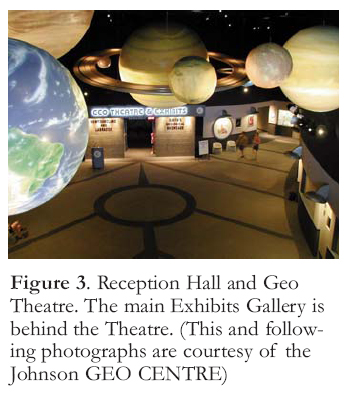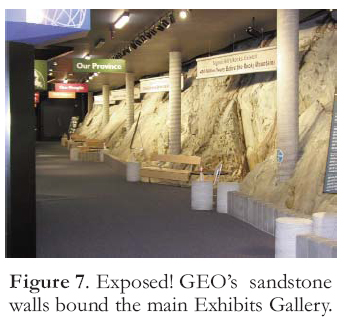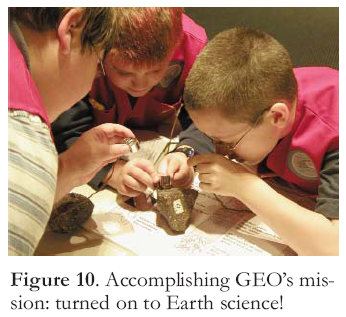Articles
The Johnson GEO CENTRE:
Earth’s Geological Showcase
R. Frank BlackwoodMember of the Board, Johnson GEO CENTRE, 175 Signal Hill Road, St. John’s, NL, Canada A1A 1B2
frankblackwood@nf.sympatico.ca
SUMMARY
The Johnson GEO CENTRE is a geological museum in St. John’s. It was built by Mr. Paul Johnson, a retired St. John’s businessman and philanthropist, after he became captivated by geology. The uniquely constructed CENTRE has several exhibits that explain the fundamentals of geoscience, demonstrate Earth history through the geology of Newfoundland and Labrador, show the evolution and world-wide migration of human beings, and emphasize the importance of Earth resources and good stewardship to the future of Earth’s peoples. Students are welcomed by entertaining, curriculum-based, geo-education programs. These and other public-awareness-of-geo-science activities are the main focus for GEO’s dedicated staff and volunteers.SOMMAIRE
Le Johnson Geo Centre est un musée géologique situé à St. John’s. Il a été construit par M. Paul Johnson, un homme d’affaire à la retraite et philanthrope, après qu’il se fut passionné pour la géologie. La construction unique du Centre comporte plusieurs expositions qui expliquent les principes de base des géosciences; décrivent l’histoire de la Terre en s’appuyant sur la géologie de Terre-Neuve et Labrador; montrent l’évolution humaine et ses grandes migrations; et soulignent l’importance des ressources terrestres et la nécessité d’une bonne intendance à cet égard, pour l’avenir des peuples de la Terre. Les programmes de géo-éducation du Centre offrent aux étudiants des contenus amusants et adaptés à leur niveau académique. Ces programmes et autres activités de sensibilisation du public aux géosciences constituent le principal centre d’intérêt des employés et bénévoles dévoués du Geo.INTRODUCTION
1 The Johnson GEO CENTRE is a first-class geological museum on Signal Hill in St. John’s, Newfoundland. The story of its origins, and what it strives to achieve, naturally begins with its founder, Mr. Paul Johnson (Fig. 1). Understanding his inspiration may provide clues as to how we might further Ward Neale’s work of spreading the Gospel of Geoscience to the citizens of Canada.
2 Mr. Johnson is a St. John’s businessman (now retired) under whose leadership the family insurance business, founded in Newfoundland in 1880, was grown to a Canada-wide provider of insurance and benefit services. Always a strong supporter of his community, and an exceptionally proud Newfoundlander, he established the Johnson Family Foundation (JFF) in 1987 to help preserve the province’s unique heritage and pursue other educational projects. One of his early projects was working with Parks Canada to recreate some of the late-1700s military infrastructure on Signal Hill.
Figure 1. Paul Jolliffe Johnson, C.M., O.N.L., LL.D. (Photo courtesy of the Johnson Family Foundation)
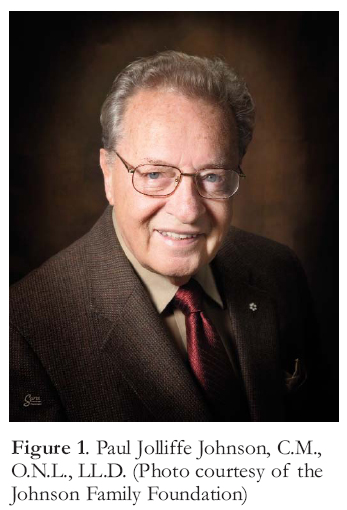
Display large image of Figure 1
3 Signal Hill is an iconic landmark on the north side of the entrance to historic St. John’s Harbour. Controlling its commanding heights was a preoccupation for (and contest between) the British and French militaries throughout most of Newfoundland’s colonial history. Its crown also contains the imposing Cabot Tower, built in 1897 to commemorate the 400th anniversary of Cabot’s discovery of Newfoundland and Queen Victoria’s Diamond Jubilee. After an agreement with Parks Canada, the JFF researched and built a late-18th-century stockade wall near the Tower, an enhancement to the federal park that is much appreciated by the annual 700 000 visitors to Signal Hill.
4 Once his attention had turned to Signal Hill, Mr. Johnson became interested in constructing walkways from the famous Hill to the equally famous Quidi Vidi Lake, home of the Royal St. John’s Regatta, the oldest continuously held sporting event in all of North America. (This initial walk-way construction led to the formation by JFF of the Grand Concourse Authority, now responsible for a system of trails in the cities of St. John’s and Mount Pearl that rival any in urban Canada.) Then it happened! During the planning for the trails leading down from Signal Hill, Mr. Johnson was introduced to, and seduced by, the wonders of geology.
5 Dr. Arthur King of Memorial University (and GAC Neale Medallist for 1997) was consulted on the rock formations exposed along the trails to Quidi Vidi Lake. Professor King is the leading researcher on the late Precambrian rocks of Signal Hill, and indeed the whole Avalon Peninsula, and he was soon regaling Mr. Johnson on the antiquity (more than 500 million years old!) of these rocks, their sedimentary features (ancient beaches, rippled sands!) and their uniqueness (more akin to Africa than North America!).
6 Our philanthropist was hooked, and was soon conferring with Dr. Hank Williams, also of Memorial University (and GAC Logan Medallist for 1988) and of Appalachian-geology fame, on the spectacular geology of Newfoundland and its importance in understanding plate-tectonic theory around the planet. Mr. Johnson thus became fascinated with the revelations that a large ocean, 450 million years ago, once separated western Newfoundland from what is now the eastern reaches of the Island; that this proto-Atlantic ocean was destroyed, resulting in the formation of the Appalachian Mountains; that the erosion of said mountains produced the sediments for our current Grand Bank shoals; and that Labrador has some of the oldest rocks in the world dating back almost 4 billion (!) years. Added to this, he was given to understand that these geoscientific concepts are integral to the sustainable exploitation of the province’s rich mineral and hydro-carbon resources. With this awareness, the nexus between captivating geology and philanthropic resources was complete.
7 Thus inspired, Mr. Johnson sought to share his geological epiphany with his fellow citizens. In 1997, he formed a five-person Planning Team to assess the viability of building a state-of-the-art geological museum/interpretation centre on (where else?) Signal Hill. This was a blue-ribbon group of individuals whose identity will help convey the foresight and commitment that went into the planning of the GEO CENTRE. The team consisted of, in alphabetical order: former Director of the Geological Survey of Newfoundland and subsequent founding Director of the Royal Tyrrell Museum of Paleontology, Dr. David Baird; acclaimed St. John’s-based architect, Mr. Charles Cullum; Memorial University geophysicist and leader in the Canadian Earth-science community, Professor Jeremy Hall; former librarian and Secretary to the Johnson Family Foundation, Ms. Heddy Peddle; and exhibit designer and consultant, Mr. George Quigley.
8 To ascertain what constitutes a superior geological museum, and what elements have the greatest success in attracting and informing visitors, the Planning Team visited eight such museums in Canada, the United States and Great Britain. By late 1997 their assessment report was done and presented to Mr. Johnson; it contained the enthusiastic recommendation that a GEO CENTRE could and should be constructed on Signal Hill, but that it would cost several more millions of dollars than originally anticipated. Undeterred, the Johnson Family Foundation immediately secured rights to the land, committed millions of Foundation dollars, and leveraged millions more, to underwrite the approximately $12-million facility that would be built on this historic site.
9 Once the “go” decision was made, Mr. Cullum began work in earnest on the CENTRE’s unique architectural design, which was completed in 2000. It was decided to minimize the footprint and skyline impact of the structure on historic Signal Hill by utilizing a sculpted glacial depression to construct the main body of the exhibit centre. Glacial debris was removed, and the revealed, striated, valley walls became the bounding walls (left exposed in the building) of the GEO CENTRE. Access to the exhibits would be through a glass-encased portal (Fig. 2) whose roof sloped downward toward the exhibit hall, which lay below the surface in the natural depression, inviting visitors to explore the Earthly delights below: The Wonder Underground was born!
Figure 2. Portal to the Johnson GEO CENTRE. (Photo taken by and courtesy of Becki Peckham)

Display large image of Figure 2
10 During the next two years, while construction proceeded, work progressed on the heart and soul of the GEO CENTRE: its Storyline and Exhibits. A Storyline Committee of geologists, chaired by Professor Hall, developed the story, multimedia presentations and, of course, rock specimens, of Earth’s (and the province’s) geological history. Exhibit design, videos and hardware construction were undertaken by the Atlantic Canada firm of Strata Group, which was specifically incorporated for the GEO project. All was ready for the Grand Opening of the Johnson GEO CENTRE in the spring of 2002, a gala event attended by local dignitaries and Canadian movie and TV celebrity Mr. Gordon Pinsent (who had also narrated the multimedia presentation for the CENTRE’s Geo Theatre). A dedicated and knowledgeable staff was in place under founding Executive Director Mr. Robert Grantham, all reporting to a Board of Directors chaired by Mr. Johnson. His dream had been realized, and the world-class showcase to the magnificence and wonderment of Earth’s geological story was ready to enthrall and educate visitors by the thousands. Below, more detail is presented on the GEO CENTRE’s exhibits (original and recent), its educational and outreach programs, and its future plans.
Figure 3. Reception Hall and Geo Theatre. The main Exhibits Gallery is behind the Theatre. (This and following photographs are courtesy of the Johnson GEO CENTRE)EARTH’S GEOLOGICAL SHOWCASE
11 The Johnson GEO CENTRE styles itself as Earth’s Geological Showcase. Through exhibits (permanent and travelling), audiovisual presentations, educational programs, outreach activities and key alliances, it hopes to instill in the public an understanding and appreciation of the antiquity, evolution and dynamism of planet Earth, and the relationship between people and Earth, including the societal importance of the sustainable use of Earth resources. The depiction of Newfoundland and Labrador’s own geological story is used to generate awe and understanding of its many phenomena, and to complement the telling of the geological evolution of the Earth itself. The following is a brief description of the main exhibits of GEO, to show how they present (geared to a Grade 9 student) a holistic picture of Earth and life on it, and how the public may be informed of, and (we hope) amazed by, the story of our planet.
Geo Theatre
12 GEO’s unique portal – the sloping roof and glass walls complement the angularity of the steeply dipping beds and joints on Signal Hill (Fig. 2) – houses a kiosk, coffee counter and a well-stocked Gift Shop. Proceeding to the back of the portal, visitors take glass-door elevators down to the Reception Hall. This is a large, three-story-high, open area wherein coloured spheres representing the solar system (planets plus their satellites and rings) are suspended from the ceiling (and in full view while descending in the elevators). At the back of the Reception Hall, and in front of the Exhibits Gallery, is the granite-clad entrance to the Geo Theatre, where a continuously playing multimedia presentation provides the introduction to GEO (Fig. 3).
13 The presentation tells the story of the birth of the solar system through to the formation and evolution of Earth. During its showing, special effects in the theatre, including sound, light and music, dramatize events with spinning orbs, simulated red-hot rocks, thunder, simulated smoke, real running water and ‘rain’. The show is interrupted periodically as narrator and ‘geologist’ Gordon Pin-sent ‘appears’ from a crevice in the ‘rock face’ that surrounds the screen to highlight particular points for clarity and interest. Graphics and Newfoundland and Labrador rocks and scenery are used in the film to demonstrate the various geological phenomena being portrayed, such as plate tectonics, the ice ages, the harbouring of life on the Blue Planet, the importance of the biosphere, and the fundamental need for sustainable use of Earth’s resources. Just as the 16-minute presentation is ending to stirring Newfoundland music, viewers are invited to begin their tour of the GEO CENTRE, as side doors to the theatre automatically open at the start of the Exhibits Gallery.
Our Planet
14 The first exhibit in the touring sequence of the Exhibits Gallery (directed by arrows on the floor) is called Our Planet; it provides a primer on how Earth works. Through models, demos, audiovisuals, posters and samples, the main concepts of earth science are explicated.
15 The pre-eminence of the sun and its influence on our planet are acknowledged; the rock and water cycles highlighted; weathering and weathering products shown; and mountain uplift depicted to continue the theme of Earth’s dynamism (Fig. 4). Explaining the Earth’s internal heat from radioactive decay leads to the subject of melting and igneous rocks, including, of course, volcanoes (demonstrated in specimens and video). Weathering phenomena help introduce sedimentation and layering of sedimentary rocks (grain-size settling is featured in a neat hands-on demo). Earth forces are used to introduce plate tectonics and explain earthquakes, metamorphic rocks and folding. The overall structure of the Earth (including an animated core-to-crust 3-D model) and the composition of the crust provide context for a rock-and-mineral display of high-quality specimens.
Figure 4. Dynamic Earth explained in Our Planet exhibit.
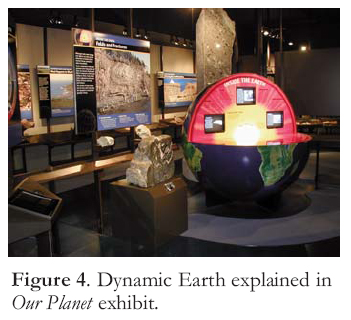
Display large image of Figure 4
16 Perhaps that most difficult (and important) of geological concepts to convey to a lay audience – deep geologic time – is dealt with in Our Planet. A large annotated time scale, several metres long, is presented of course, but some understanding of what the billions of years mean is demonstrated in the adjacent ‘Sands of Time’ display. At this display, transparent columns contain grains of sand, from just 75 grains to represent a 75-year human life span in a virtually empty column, to millions of grains in a filled metre-high column to show the time of dinosaur extinction 65 million years ago. A floor-to-ceiling column filled with sand, and showing its continuing (by graphic) through the roof of the GEO CENTRE and reaching well above it, attempts to give an organic feel for the immense antiquity of the Earth. Located nearby, a display on the importance of superposition of strata in sediments, as well as the fossils these layers contain, relates chronology and evolution of life. Geochronology and unconformities are also introduced. Visitors leave Our Planet, we hope, with a basic understanding of the age and dynamism of Earth, and how these fundamentals influence several key geological processes, thereby ready to enjoy and understand the rest that GEO has to offer.
Our Province
17 It’s no secret that Newfoundland is geologically renowned for its preservation and exposure of rocks that record the formation and closure of the proto-Atlantic or Iapetus Ocean. Spectacular coastal exposures and glacially scoured hilltops provide an unparalleled cross-section through continental margins, oceanic crust (in situ and obducted), island arcs, back arcs, and sedimentary basins. Similarly, the magnificent exposures along the shorelines and barrens of Labrador are a boon to unravelling the mysteries of the Canadian Shield in eastern Canada. With some of Canada’s oldest rocks (at nearly 4 billion years) in northern Labrador, and hydrocarbon-rich Mesozoic rocks underlying the continental shelf, the province’s geology represents a significant swath of Earth history (Fig. 5).
Figure 5. Entrance to Our Province exhibit. The block of rock at the start is a piece of obducted mantle from western Newfoundland.
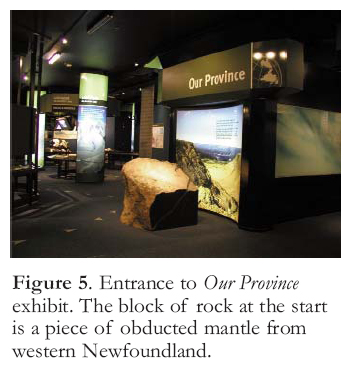
Display large image of Figure 5
18 Newfoundland (Appalachian) and Labrador (Canadian Shield) geology are treated separately in the exhibit. Two circular modules with multiple TV monitors suspended over representative rock samples tell the story of these two distinct regions in audiovisual format. The Labrador – An Ancient Land video deals with the great age of the Canadian Shield and how it was constructed through continental accretion, the result of which we see today in the various structural provinces. The development of an oxygen-rich atmosphere is highlighted by the deposition of the great iron deposits of western Labrador. Igneous activity includes reference to the famous Labrador anorthosites and the Voisey’s Bay nickel deposit. The Labrador story ends with the beginning of the Newfoundland story 600 million years ago.
19 The Newfoundland – A Younger Land video starts with the breakup of Rodinia. It takes us through to the development of the Appalachian Mountains and the formation of Pangea, with stops in between, such as the obduction of ophiolites exposed at the UNESCO World Heritage Site in Gros Morne National Park, western Newfoundland. Plate tectonics, continental drift and the famous continent – ocean – continent zonation of Newfoundland are all covered. The role of the redoubtable Dr. Hank Williams in deciphering this history, as well as his acclaimed Map of the Appalachians, is a separate feature in the exhibit. The Newfoundland Island story ends with the beginning of the modern Atlantic Ocean.
20 A third module shows the Birth of the Atlantic video. It starts with the breakup of Pangea and the formation of the continental shelves as the modern Atlantic gets ever wider. Rift valleys, erosion, flood plains, sedimentary basins, and marine organisms are all explained as contributors to the world-famous Grand Banks of Newfoundland and the eventual formation of offshore oil and gas deposits. Imaginations are stirred by the explanation that dinosaurs once roamed the long-buried marshlands of the continental shelf, that a still-spreading Atlantic Ocean causes periodic seismic activity in eastern Canada, and that on our restless planet, erosion and deposition are continuous processes.
21 The eastern zone of Newfoundland, underlain by ‘Avalonia’, gets its own treatment in Our Province. Suffice it to say that this exotic piece of geology, a remnant of Gondwanaland left behind after the breakup of Pangea, is the ‘home’ of the GEO CENTRE and is given special attention. Its mineral deposits and fossils (including the incredible Ediacaran fauna at Mistaken Point) are all highlighted. Near this part of the exhibit, a series of globes shows the travels of the continents since the Neoproterozoic, from Rodinia to Pangea to today’s configuration.
22 Our Province ends with a treatment of glaciation in a special ‘glacier’ theatre (temperature is kept a few degrees cooler inside) where a video narrated again by Mr. Pinsent explains the impact of the ice ages on the world, Canada, and Newfoundland and Labrador. The video ends with life (including people) re-inhabiting the land after the last ice age. Upon leaving this mini-theatre, one hopes the visitor has seen Earth history through the geology of Newfoundland and Labrador, and is ready for the next exhibit.
Our People
23 Visitors to the Our People exhibit are welcomed by a large Inukshuk made from stones shipped from Labrador, to represent the Thule and Inuit cultures of Labrador and northern Canada. An Inuit Labradorian assembled the Inukshuk before the opening of GEO.
24 In this exhibit, human origins and development (the main focus) are considered in the context of the evolution of life on Earth. It explains that single-celled life began billions of years ago and evolved through the complex life forms represented in the fossil record, to those present today. Throughout the vastness of time, many species became extinct and new ones evolved, largely owing to changing conditions on Earth. The exhibit explains that very late in the story of life, Homo sapiens evolved from primate ancestors. Early hominids are dramatized by replicas of the Laetoli Track-way - fossilized footprints from Tanzania, and ‘Lucy’ - a partial Australopithecus afarensis skeleton from Ethiopia (Fig. 6).
25 The evolution from primitive to modern humans and the migration out of Africa are documented in words and graphics. The peopling of North America (eastward migration from Asia) is shown to occur in the wake of the retreating Laurentide ice sheet, including the movement of aboriginal peoples into Newfoundland and Labrador. With the westward journeys of Europeans to the ‘New World’, beginning when Viking voyagers meet native North Americans in Newfoundland around 1000 C.E., human beings have completed a ‘full circle’ from their African birthplace.
Figure 6. An Inukshuk greets visitors to the Our People exhibit. ‘Lucy’ is in the background.
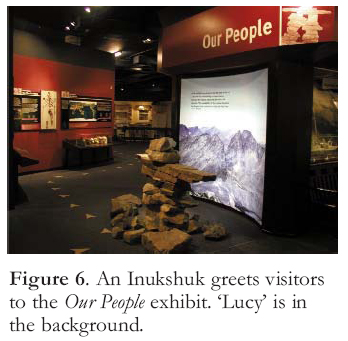
Display large image of Figure 6
26 The second part of the Our People exhibit deals with our contemporary world and civilization’s dependence on Earth’s resources, geological and otherwise. A modern-kitchen display with an audio commentary entitled Out of the Earth demonstrates the omnipresence of mineral products in our everyday lives. A prospector-camp display/mini-theatre shows a video entitled Searching for Knowledge; Searching for Wealth wherein the importance of geological maps (and the historical evolution of same in Newfoundland and Labrador) is declared crucial for modern-day mineral and hydrocarbon exploration. Visitors are reminded that the land and sea have always provided for man’s sustenance, and that a quest for knowledge is fundamental to our future sustainable use of Earth’s bounty.
Our Future
27 The penultimate exhibit in the main Exhibits Gallery is Our Future. It consists of a video called Earth’s Future, Our Future, and it plays in a dome-shaped mini-theatre. The video focuses on the changing nature of our planet, from its fiery birth to today’s life-conducive conditions. The pivotal role of the sun and terrestrial events like volcanism are related to Earth’s changing climate throughout geologic time. Cooling and warming cycles, and the related glacial advances and retreats, are explained, as well as the impact of greenhouse gases on global warming. Contemporary concerns about climate change are presented in the context of Earth history, scientific research, the use of fossil fuels, and the potential for both positive and negative impacts. The video also deals with our use of resources, including fossil fuels and alternate energy. And the importance of clean, safe water is emphasized. Finally, we are reminded of the need for good stewardship with the closing exhortation: “So whether your home is here in Newfoundland and Labrador, or any other nation on the globe, treasure and protect this world, and our Earth will always be the Blue Planet.”
The Stellarium
28 The final exhibit in the main Exhibits Gallery is a stellarium, located at the back of the gallery. It brings together the Space theme introduced by the impressive solar-system display in the Reception Hall. (In fact, Space is a significant ancillary theme at the GEO CENTRE, which has concluded an agreement with NASA to broadcast its video feed from the Mars Rover program in GEO’s 85-seat auditorium located off the Reception Hall.) As well as a tour through the 250 stars closest to our solar system, the Stellariun voice-over provides a description of our sun’s giant-to-dwarf future. In the ‘foyer’ of the stellarium exhibit, numerous photos of space and the Manned Space Platform are mounted.
GEO’s Rock Walls
29 Returning to the Reception Hall from the Stellarium, one walks along the exposed, steeply dipping, bedded-sandstone walls of the GEO CENTRE (Fig. 7). Signage touts the antiquity of these rocks in relation to other seminal events in the geological evolution of the Earth and of Canada, e.g. the age of dinosaurs, and the birth of the Rocky Mountains. The walls are a magnet for children (although rock climbing is prohibited for safety reasons!), and various primary features developed on the bedding surfaces, as well as cracks and veins, get pointed out to visitors by GEO’s interpretation staff. Arriving back in the Reception Hall, one has truly gained the impression that the GEO CENTRE is The Wonder Underground.
Figure 7. Exposed! GEO’s sandstone walls bound the main Exhibits Gallery.ExxonMobil Oil and Gas Gallery
30 Built after the opening of GEO, the ExxonMobil Oil and Gas Gallery is a state-of-the-art exhibit on hydrocarbons, from their geological formation to end uses, and, naturally, this being Newfoundland and Labrador, an emphasis is placed on their occurrence and extraction in the offshore. A partnership was entered into with Exxon-Mobil Canada to sponsor GEO’s oiland-gas gallery. A Storyline Committee, chaired by GEO and including geoscientists from the company, was established to determine, and write, the content for the exhibit. The gallery was opened to the public in June 2005, and is a sterling example of what can be achieved by active corporate participation in GEO’s educational mission.
31 The unique entrance to the ExxonMobil Oil and Gas Gallery is off the Reception Hall, and simulates in design, material and sound, a transport helicopter landing on the helipad of an offshore oil platform. Once ‘landed’, visitors are treated to a display of familiar materials that highlight the importance of petroleum products in our everyday lives. Next, through posters, audiovisuals, and interactive props, the science of hydrocarbons is explained: What are oil and gas? Where do they come from? The chemistry of hydrocarbons, how they formed from organic remains in sedimentary rocks, the importance of porosity and permeability, and the development of sedimentary basins and reservoirs, are all explained and depicted.
32 Exploring for hydrocarbons is covered, particularly the use of seismic surveys, geological interpretation and drilling. A mini-theatre offers a custom-made video (as are all of GEO’s videos) that deals with offshore exploration and recovery, focusing on the science and technology involved, such as horizontal drilling. Just beyond the theatre, the exhibit focuses on the extraction of oil, with large, detailed models of the SeaRose, a Floating Production, Storage and Offloading (FPSO) vessel used in the White Rose field, and the Hibernia Platform. Getting oil to market is also covered (by tankers, trucks etc.), including the refining that renders crude into the useful, familiar products that we use daily. The industry’s focus on protection of the environment and workers’ safety is emphasized, along with the need for constant vigilance, poignantly so with the exhibit’s acknowledgement of the tragic loss of the Ocean Ranger drilling platform in 1982, during the early years of offshore exploration.
33 The ExxonMobil Oil and Gas Gallery, near its end, looks at our energy needs and uses in the future, including alternative forms of energy (pointing out that the Johnson GEO CENTRE itself is heated and cooled by a geothermal heating system). In conclusion, the point is made that for this exciting, high-tech industry to thrive, it is essential to have centres of excellence, such as Memorial University, to produce the workers needed for the diverse careers in exploration, discovery, extraction, and delivery of oil and gas.
The Titanic Story
34 A somewhat unusual exhibit, given that the GEO CENTRE’s focus is on earth science, tells the story of the Titanic and her tragic sinking in 1912 after colliding with an iceberg 560 km to the southeast of Newfoundland. Mr. Johnson was made aware of a collection of Titanic reproductions, artifacts (removed from the actual ship before her sailing) and movie props (from Mr. James Cameron’s famous movie) that needed a place for permanent display. A room off the Reception Hall was made available, and the production of posters, displays and models (including the famous ship as she presently lies on the bottom of the North Atlantic, and as she was discovered by renowned earth scientist, oceanographer and explorer Dr. Robert Ballard) was done to exacting GEO exhibit standards.
35 The Titanic Story opened in 2004, and has become a very popular exhibit with visitors. It provides an absorbing digression from GEO’s theme, although the age-old annual calving of icebergs off Greenland’s glacier (a remnant of the Laurentide ice sheet), the ocean currents that produce ‘iceberg alley’ off Newfoundland’s shores, and the discovery of the wreck of the Titanic, are all elements that fall within the embrace of GEO’s natural-history mandate. In any event, regular visitors, as well as amateur Titanic historians, have all lauded the exhibit as one of the best they have seen.
Kids Room
36 As previously mentioned, the exhibits at the GEO CENTRE are written to a Grade 9 junior-high-school standard. Obviously, however, many younger visitors often accompany older family members on a trip to GEO. Besides educational programs specifically oriented to primary-school kids, GEO uses mobile Kids exhibits, placed strategically through the facility, to engross and entertain the younger set (e.g. a xylophone made of drill core). Recently this concept was expanded into a Kids Room, again off the Reception Hall, wherein the walls are painted with age-appropriate images of space, primordial Earth, fossils and dinosaurs, and mounted 3-D depictions of crystals. Play stations are placed throughout the room, including a puppet theatre. This room has become very popular with families: while one adult supervises the younger children in the Kids Room, the other adult(s) can accompany the older kids around the main exhibits.
JOHNSON GEO PARK
37 Surrounding the GEO CENTRE on three sides is the 15-hectare Johnson GEO PARK (Fig. 8). When Mr. Johnson secured the long-term lease from the provincial government for the GEO CENTRE, it contained provisions for expansion of the lease to include a geological park. To plan the park, Mr. Johnson secured the foundational involvement of two prominent scientists from Memorial University: Dr. Arthur King, geoscientist and aforementioned inspirer for the Johnson GEO CENTRE; and Dr. Wilf Nicholls, botanist and Director of Memorial’s Botanical Garden. The interpretative focus of GEO PARK is the geology and botany represented in the natural landscape surrounding the GEO CENTRE on Signal Hill. Subsequent to its completion, ownership of GEO PARK was formally transferred to the Johnson GEO CENTRE Foundation Inc.
Figure 8. GEO PARK overlooks the city of St. John’s. In the foreground are some of the PARK’s trails, out-crops and stoneworks.
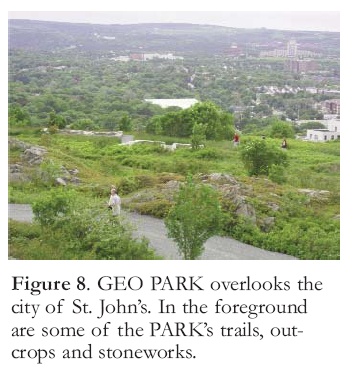
Display large image of Figure 8
38 GEO PARK contains eight, wheelchair-accessible, looped walkways of nearly two kilometres in aggregate length that are disposed around the GEO CENTRE. From just about anywhere in the PARK, the spectacular panorama of the city of St. John’s, including its locational relationship to the area’s geology and geomorphology, is visible. Along the walkways, Johnson Family Foundation-patented History-boards® explicate in text and graphics the regional and landscape features of the geology, as well as outcrop-scale features and phenomena. Similarly, the PARK’s botany is the focus of Historyboards® that explain the role of climate and soil in plant development, and highlight the various native and introduced species in the PARK.
39 A bonus feature of GEO PARK is the development of eleven models of traditional stone structures used in Newfoundland and Labrador. Designed by GEO CENTRE architect Charles Cullum, the stonework replicas are disposed along the PARK’s first walkway and represent such past and present structures as fireplaces, root cellars, wharfs and Inukshuks. The Stoneworks Walk is a fascinating cultural complement to the natural-history focus of GEO PARK.
40 GEO PARK also includes a ‘traverse’ across Newfoundland’s main tectonostratigraphic zones as represented by 1- to 2-tonne blocks of cutand-polished representative rock types situated close to the CENTRE’s entrance. All together, the PARK represents a tremendous asset to the GEO CENTRE and its mission. It is free to visitors and is an inducement for them to visit the CENTRE for an expansion on the GEO experience. Guided tours of the PARK are provided by GEO’s interpretation staff, and its educational and scenic appeal is included and promoted in GEO’s programming.
GEO EDUCATION AND OUTREACH
41 The exhibits at the GEO CENTRE, and the uniqueness of the facility itself, are the primary features that attract and educate the general public, young and old. However, the CENTRE has a formal educational program directed at students that is both substantive and effective. Called Geo Classes, these are currently developed and aimed at grades 2-6. Material in the classes (held in two classrooms off the Reception Hall in which one side in each room is the exposed rock wall) has been developed by GEO staff in active consultation with science teachers, for school-curriculum conformity and age-appropriate detail. Lasting one-and-one-half hours each, students in these classes assume the role of scientists who are researching various topics, for example, the water cycle for Grade 2, and rocks and minerals for Grade 4. Classes are led by GEO Interpreters and can accommodate up to 60 students at a time (must be booked in advance by schools). The CENTRE hosts, on average, 70 Geo Classes a year to teachers’ acclaim and students’ delight.
42 Complementing Geo Classes is the School Visits program. Open to all grade levels from K to 12, and available throughout the week, these are one-and-one-half-hour sessions that consist of a 20-minute presentation by Interpretation staff, the multimedia show in the Geo Theatre, and a tour through the exhibit galleries. Again, through content, worksheets and focus, these visits are geared to the various grade levels and particular course curricula, and include such offerings as The Whispering Rock (rock types, etc.), Waves of Tragedy (tidal waves with Newfoundland example), and Buried in Ice (glaciation). Finally, student groups are offered tours of the geological, botanical and cultural points of interest in the GEO PARK.
43 Most current formal student programming is directed at the elementary grades; junior-high classes are in development. However, a major teaching resource, the Geo EDUKIT, as of spring 2009, is being piloted by five science teachers to ensure its maximum compatibility as a support to Newfoundland and Labrador’s high-school earth-science course. Once final modifications are made, the EDUKIT will be distributed to schools. It consists of a substantive package of lesson plans, worksheets, demonstrations, maps, rock and mineral specimens and other helpful materials. Funding for developing the kit was provided by the JFF, NSERC’s PromoScience Program, and ExxonMobil.
44 Situated as it is in the easternmost part of Newfoundland and Labrador, the Johnson GEO CENTRE has a keen desire to make its educational resources available to students throughout the province via a Distance Education Program. To this end, it is entering into discussions with the provincial Department of Education and, particularly, its Centre for Distance Education and Innovation, to investigate ways of providing resources and inspiration for all students eager to learn about the Earth. To achieve these goals, the GEO CENTRE will use computer technology, travelling displays, school visits and the distribution of hands-on materials. This is a major undertaking, and its success will depend upon developing effective partnerships with like-minded agencies and public-spirited benefactors.
45 Proactive educational outreach is an ongoing priority for GEO staff and Board committees. For example, space and facilities are given free for teacher in-services, in exchange for their receiving an information session on GEO’s programs and exhibits. Teachers are invited to comment on and modify all GEO programs developed for the schools. And a good working relationship is maintained with curriculum developers in the Department of Education.
46 Public Lectures are a free and regular feature at the GEO CENTRE, and those presented to commemorate the International Year of Planet Earth (IYPE) have been especially well attended (speakers have come from the St. John’s geoscience community, the Geological Survey of Canada, and even internationally, e.g. Dr. Robert Ballard, scientist emeritus, Woods Hole Oceanographic Institute). The general public and students are also invited to a series of Special Events hosted by GEO throughout the year. These include Earth Day celebrations (featuring, for example, ‘Stump a Geologist’, ‘Panning for Gold’ (Fig. 9), and solar observations guided by members of the St. John’s chapter of the Royal Astronomical Society of Canada); a bridge-building competition sponsored by National Engineering and Geo-science Week; and ‘Doors Open St. John’s’, an event during which the GEO CENTRE and other museums and institutions in the city offer a free exploration of exhibits and facilities. Finally, GEO renews interest in its mission and complements its permanent galleries by hosting Travelling Exhibits, mostly during the off season. These are displayed in the Celestial Gallery, new space developed at the entry level and leading off the main entrance. Some of these temporary exhibits have enjoyed corporate sponsorship and helped generate valuable media interest. Exhibits hosted to date include: Dinosaurs and Company, From Crystals to Gems, and Arctic Adventure.
Figure 9. Panning for gold at a ‘mineral exploration camp’.PARTNERSHIPS
47 For any successful public-education endeavour, developing effective partnerships is key to leveraging greater goal-oriented effort and ensuring success. By pursuing this strategy, the Johnson GEO CENTRE enjoys a number of mutually beneficial relationships with local and national institutions and organizations. The most consequential is its partnership with Memorial University of Newfoundland (MUN), as formalized through the negotiated 2007 Management Agreement Plan (MAP). The MAP recognizes that the GEO CENTRE benefits from the active involvement of the university in its programming and governance (six of 11 Board members come from Memorial), and that MUN students, faculty and staff have much to gain from GEO’s exhibits, facilities and programs.
48 The GEO CENTRE also enjoys an informal partnership with the Earth Sciences Department at MUN. Faculty members give public lectures at GEO, serve on the Board and bring first-year students to the exhibits. Likewise, geoscientists from the Geological Survey of Newfoundland and Labrador (GSNL) of the provincial Department of Natural Resources, are devoted supporters of the GEO mission through public lectures, sample collections, exhibits development and special-events participation. Clearly, MUN earth sciences and GSNL are two fundamentally important partners in achieving GEO’s goals.
49 Other groups with which GEO is affiliated/associated include the Canadian Space Agency (Canadian astronaut Julie Payette visited GEO and made a presentation to 400 school kids); the Museum Association of Newfoundland and Labrador (which provides an opportunity to share experiences and problem solving with confreres operating in the same environment); the Canadian Association of Science Centres (which extends membership privileges to all members of participating centres across Canada); the Newfoundland and Labrador Section of the Geological Association of Canada (which meets regularly at the GEO CENTRE and sponsors an annual public lecture there); the local chapter of the Royal Astronomical Society of Canada (which meets at GEO and sponsors educational events at the CENTRE); and the Royal Ontario Museum (which was involved in a project to produce a cast of the bedding surface at Mistaken Point, Newfoundland, that contains the world-famous Ediacaran fossils). Finally, GEO participates in a MultiPass program with other museums and exhibitions in St. John’s and environs, to facilitate visitation to the several local venues by those with a penchant for learning and fun.
FUTURE PLANS
50 The Johnson GEO CENTRE opened its doors in 2002. Since then, two major exhibits have been added to the original gallery. There is one important area, however, that was always part of the original plan but has yet to be constructed, and that is a Mines and Minerals Gallery. A preliminary proposal for the gallery has been prepared by the Board’s Curatorial Committee, and approaches have been made to several large mining companies with the hope of securing a patron for Mines and Minerals similar to the way ExxonMobil sponsored the Oil and Gas Gallery. The new gallery will cover the geological origins, historical uses and societal impacts of minerals. Current plans also include an adit off the gallery to give visitors a sense, as close as possible, of what it is like to be in an underground mine. Active fundraising for this project is ongoing.
51 Of course, renewing exhibits and planning new ones are essential to keeping GEO vital, relevant and attractive to the visiting public. Other smaller exhibits in the works include a Pale-ontology Display focusing on the fossils of Newfoundland, and a Geothermal Energy Display that will depict the actual heating and cooling system used by the GEO CENTRE. Longer term plans (to be facilitated by the success of GEO’s active and ongoing fundraising efforts) include the possibility of expansion to a second floor where aspects of the biosphere may be the focus. Time, resources and a responsive public will dictate progress toward these future goals.
CONCLUDING COMMENTS
52 Mr. Johnson was inspired to build the GEO CENTRE. Its edifice and exhibits are ranked by all who visit as world class. But to sustain such a venture requires the commitment, creativity and energy of a broad range of supporters and players. Reference has already been made to the importance of partnerships, with institutions and individuals. Equally important is the dedication of the 11-member Board, appointed by Mr. Johnson to oversee all aspects of the operation of the Johnson GEO CENTRE Foundation Inc. A brief profile of the Board will convey the level of expertise represented by its members, and the important advantage this provides to realizing GEO’s vision. As mentioned, the Board includes six members to represent Memorial University under the MAP, and these include senior academics (e.g., a Vice-President and a former Dean) and senior managers (e.g., directors of services). Dr. Alice Collins, the former Dean of Education at Memorial University, currently chairs the Board. Other Board members include GEO’s architect, senior executives from the local business community, two geoscientists, a lawyer (and former Lieutenant Governor of Newfoundland and Labrador), and, of course, the founder himself, who serves as Vice-Chair. GEO’s Executive Director and Financial Manager are ex-officio (but non-voting) members of the Board.
53 This brings this snapshot of the GEO CENTRE around to that essential element for its success: the staff and volunteers. Without the application of their talent and time to the GEO mission, nothing succeeds (Fig. 10). Led by current Executive Director Mr. Paul Dean (a geologist and former Deputy Minister in the provincial government), the nine permanent staff members include university graduates in geology, education, biology, archeology and business. Their devotion to GEO is demonstrated every day in the skill, excitement, energy and extra hours that they bring to the presentation of exhibits and programs to GEO’s visitors. Ideas for improvement of all aspects of GEO are enthusiastically brought to the Board and/or its committees. The staff also coordinates the role of some 15 dedicated volunteers (many are retired professionals), without whom the breadth and diversity of the GEO program would not be possible. Also, part-time interpreters, many of whom are MUN undergraduates, lead tours and help with classes. Indeed, it is the synergy between staff, volunteers, interpreters and visitors that makes the magnificence of Earth history, as depicted at the Johnson GEO CENTRE, come alive. Ward Neale would be proud! And so will you be when you drop by for a visit the next time you are in St. John’s, Newfoundland.
Figure 10. Accomplishing GEO’s mission: turned on to Earth science!ACKNOWLEDGEMENTS
My colleague and fellow Johnson GEO CENTRE Board member, Professor Jeremy Hall of Memorial University, kindly reviewed the paper and made helpful suggestions for improvement. The GEO CENTRE’s Supervisor of Public Programs and Exhibits (and former Supervisor of Education Programs), Mr. Keith Moore, provided information on GEO’s education programs, and made available the selection of GEO photos used in the article. And Dr. Paul Johnson is thanked for inviting the author to join the Board of the GEO CENTRE in 2001; it has been a truly rewarding experience.